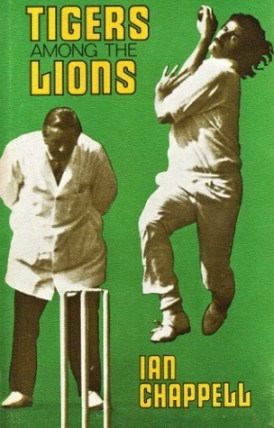Tigers Among the Lions
Archie Mac |Published: 1972
Pages: 190
Author: Chappell, Ian
Publisher: Investigator Press
Rating: 2.5 stars

Tigers Among the Lions might be best described as a forerunner to the popular Australian captain’s tour diaries propagated by Chappell’s modern counterparts. Scraping to 190 pages, due mainly to complete score cards and copious black and white photographs throughout, this book is a rather perfunctoy account of the Ashes tour of 1972.
Chappell had plenty to work with as the series finished two all, rare for the time as they used to play many more draws, and featured two fine bowling performances. The less famous was that by, perhaps the greatest exponent of a tailor made pitch, ‘Deadly’ Derek Underwood.
‘Deadly’ destroyed Australia in the crucial fourth Test, the score was one Test each going into the match, by claiming 4-37 & 6-45. The victory retained the Ashes for England which had been secured in 1970-71. The pitch for the match, Leeds, was considered at the time to be a fast bowlers’ wicket, however the one that greeted the Aussies was bereft of grass and Underwood was selected for his first Test of the series.
At the time the newspapers were full of indignant reports by the Australian press, with Jack Fingleton being the most vociferous, although John Arlott was hardly less censorious. The charge was that the pitch had been specifically prepared for Underwood.
While most in the media were involved in a great debate over the possible, deliberate, doctoring of the pitch – In Tigers Among the Lions, Chappell simply writes: ‘many people sympathised with us but there was no point in complaining’. While his lack of complaining is admirable it hardly makes for good reading.
The other great bowling performance in the series occurred in the second Test and featured the greatest début in cricket history with Bob Massie claiming 8-84 & 8-53 at Lords. Again this is covered in a fairly brief manner although Chappelli does finish the coverage of the fourth Test with some strident and deserving praise: ‘Obviously Bob Massie, who virtually re-wrote the record book with his great bowling performances of 16 wickets for 137 runs, was the hero’.
Chappelli does give some insight into the players’ life on tour, which seemed to be very active. Chappell was either playing golf, squash, or visiting Wimbledon in between matches, which almost all seem to be affected by rain. While this is interesting there is no mention of ‘big nights’ or rowdy tour behaviour.
The other aspect that was of interest was the attitude of Chappell towards one day cricket: ‘even the one day series, light hearted as it was’. Chappell thought that too much one day cricket would lead to a more defensive attitude in other forms of cricket.
At the end of the book Chappelli expresses the opinion that the tour, although they didn’t win the Ashes, was successful and that Australia had the making of a ‘strong’ team for the future. He was certainly right in that assessment with Rod Marsh, Dennis Lillee, Greg Chappell and himself forming the nucleus of the ‘ugly Australians’ that would soon be the dominate Test team in the World.
All in all, an average book, which is probably not worth the trouble to read, although as a positive there are no typos. One thing Chappelli does explain is the reason for the word Tiger in the title. Apparently this was the nickname of Lillee and also he draws a tenuous link to WA players having black and yellow as their state colours.






Leave a comment